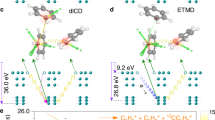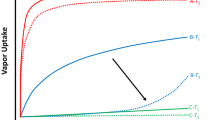Abstract
THE first and probably largest single step in the solution of the spectroscopic problem of the structure and vibrations of benzene was taken when, by comparison of the Raman and infra-red spectra of C6H6 and C6D6, the eleven active fundamental frequencies were identified, and shown to have isotope shifts agreeing with an application of Teller's theorem to the D6h model1. It remained to determine the nine inactive frequencies, and secure the confirmation they should yield. For this purpose the plan outlined was to remove symmetry piecemeal by oriented deuteration in the sequence 1: 3: 5-C6H3D3 (no centre), ]: 4-C6H4D2 (no 3-fold axis), C6H5D (no centre, no 3-fold axis), thus allowing previously inactive frequencies to become active a few at a time.
This is a preview of subscription content, access via your institution
Access options
Subscribe to this journal
Receive 51 print issues and online access
$199.00 per year
only $3.90 per issue
Buy this article
- Purchase on SpringerLink
- Instant access to full article PDF
Prices may be subject to local taxes which are calculated during checkout
Similar content being viewed by others
References
NATURE, 135, 1033; 136, 680 (1935). J. Chem. Soc. (1936), nine papers.
J. Chem. Soc., 1637 (1936).
Naturwiss., 23, 624 (1935).
J. Phys. Chem., 41, 149 (1937).
Author information
Authors and Affiliations
Rights and permissions
About this article
Cite this article
BAILEY, C., BEST, A., GORDON, R. et al. s-Trideuterobenzene and the Structure of Benzene. Nature 139, 880 (1937). https://doi.org/10.1038/139880a0
Issue date:
DOI: https://doi.org/10.1038/139880a0
This article is cited by
-
Zur Lagenbest�ndigkeit der Frequenz ? ? 1000 cm?1 in mono- und symm. tri-substituiertem Benzol
Die Naturwissenschaften (1937)



